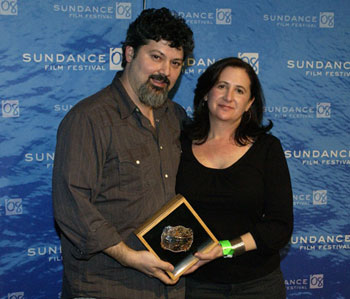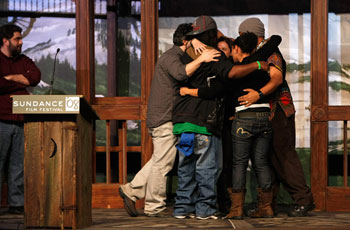Carl Deal & Tia Lessin

Carl Deal and Tia Lessin are the producers and directors of the Academy Award-nominated documentary Trouble the Water, which follows the lives of Ninth Ward residents Kimberly and Scott Roberts during the aftermath of Katrina’s devastation of their homes in New Orleans. The film won the Gotham Independent Film Award and the Sundance Film Festival’s Grand Jury Prize, and is now available on DVD. Both Lessin and Deal continue to advocate assistance for impoverished, post-Katrina communities.
TMN: How did you initially come across Kimberly and Scott Roberts’s tape?
Tia Lessin: Carl and I wanted to do something in the aftermath of Katrina. We were stunned and outraged by the failures of our government, and, like so many others, we decided to channel that into action. So we put ourselves in central Louisiana about a week after the levees broke to make a film. That’s where Kimberly and Scott Roberts approached us, about 10 days after the levees failed. We were all at a Red Cross shelter. They were just at the beginning of their post-Katrina journey, and we had just been shut down by the military after filming several days with Louisiana National Guard soldiers returning home from Baghdad. Kimberly pitched us on the video she had shot on the days before and during Katrina: “What I got, I’ve been saving it, ‘cause I don’t want to give it to nobody local. This needs to be worldwide. ‘Cause all the footage I’ve seen on TV, nobody got what I got. I got right there in the hurricane.”
When we first saw the home video, we were stunned. It was most definitely not the Katrina broadcast on television. It was ground zero, intimate, raw. Our editor and co-producer T. Woody Richman painstakingly worked with it, and 15 minutes of that footage anchors the first part of Trouble the Water. Working with award-winning cinematographer P.J. Raval, we then filmed with Kimberly and Scott on and off for the next two years. And through all that, we were able to distill so much into one story—the abandonment of the city’s poorest, the incarcerated, and the hospitalized to Katrina’s floodwaters, and the government’s failures long before, during, and after the storm.
TMN: In what ways, as mentioned in the film, is “Katrina still going on?”
Carl Deal: Our executive producer, Danny Glover, put it this way: “When the hurricane struck, it did not turn the region into a Third World country—it revealed one.” The region and people along the Gulf Coast had been neglected by government institutions long before the levees failed in New Orleans, and Trouble the Water provides a window into that experience. And in the four years now since Katrina hit, very little has been done to reverse that. Tens of thousands of people still wish to return to their homes, but can’t. And those who have continue to face hardships. Rents have doubled and many homes remain unsafe; living-wage jobs remain scarce; the tourist economy remains the first option for redevelopment, as opposed to more sustainable and life-supporting development such as creating a green infrastructure would have; and schools continue to underperform. So the institutional failures that Katrina represented are still going on. Fortunately, the efforts to counter those failures are strong and meaningful.

TMN: What is your favorite object in your office?
TL & CD: The copper belt buckle we received from the Sundance Film Festival is our favorite object in the office. We are so grateful for that recognition. There’s also a picture of us and the team at Sundance feeling the joy after the Grand Jury prize was announced.
TMN: Have there been any significant efforts to rebuild the Ninth Ward?
CD: There are so many residents fighting every day to rebuild their communities, with and without government support. Mostly without. And of course there are so many meaningful projects, like the green building project of the Make it Right Foundation that is creating safe and sustainable housing close to the levee in the lower Ninth Ward. And colleges and high schools continue to send students to the region to volunteer, through alternative spring break programs, churches, and other community groups. We’ve listed on our web site many of the organizations that are working for equity in the rebuilding of the Gulf Coast, but so much more needs to be done.
TMN: What’s something you’re not good at but wish you were?
TL: Ice skating.
